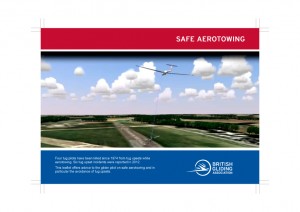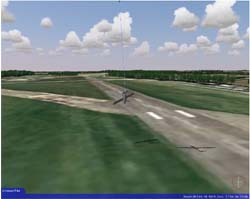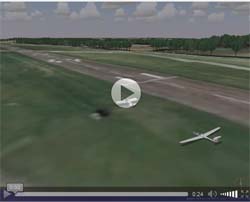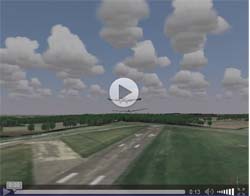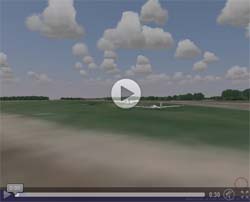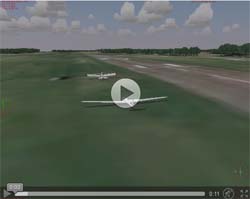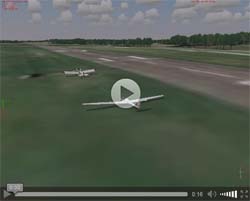Safe Aerotowing
Aerotowing may appear to be a benign method of getting airborne in a glider, but there are inherent hazards, the most significant of which are detailed below.
Distraction and Assumption
Pilots should be diligent in carrying out the pre-flight checks and remain vigilant throughout the launch. Distraction is a major cause of accidents; pilots should not allow themselves to become distracted during the pre-flight checks and the tow. Navigation devices, radio, FLARM, loggers and cameras should be switched on and set up before carrying out the pre-flight checks.During the tow, the glider pilot’s focus must remain fixed on maintaining the glider’s correct position behind the tug aircraft.
Airbrakes opening during an aerotow have led some glider pilots to make an incorrect assumption about tug performance and/or sinking air. If a glider is not climbing as expected on tow, the glider pilot should look and physically CHECK that the airbrakes are locked (plus correct flap setting and drag chute not deployed).
Tug Upsets
Personal injury accidents to the glider pilot while aerotowing are rare but the tug pilot can be killed if the glider gets too high and forces the tug into a vertical dive.
An educational campaign on safe aerotowing followed five fatal tug upset accidents between 1978 and 1985. The fatal accidents stopped and the frequency of tug upset incidents remained at less than one per year until 2008. Since 2009, however, there have been over 3 upsets per year. There were 7 in 2019. Recent tug upsets have included recovery ‘at 40ft’, ‘at 50ft’, and ‘ below the height of pylons’.
ALL tugs are vulnerable to an upset but light tugs are more vulnerable.
The following factors may cumulatively contribute to a hazardous situation. Where more than one item is present, advice should be sought before launching:
- Low experience of glider and/or tug pilot
- Gliders fitted with C of G hook only
- Glider’s C of G towards the aft limit
- Turbulent air in the take-off area
- Rough ground in the take-off area
- Significant cross-wind component
- Short rope
- Light-weight glider, low wing loading
The BGA has published a ‘Safe Aerotowing’ leaflet with particular emphasis on avoiding tug upsets. Please collect a copy from your club or download a copy from this page. The leaflet contains stills from the video simulations of tug upsets that follow this guidance.
If you are the GLIDER PILOT;
- If you are inexperienced, do not aerotow on a belly hook and do not aerotow in turbulent conditions.
- Stay focused on the tug at all times. Maintain the correct vertical position of the tug in the canopy. Do not allow the glider to get too high.
- If you are too low behind the tug shortly after the tug take off, or at any other time, move back into position SLOWLY. Being lower than the tug is not dangerous. An upset can follow if you pull up quickly.
- Release immediately if the glider is going high and the tendency cannot be controlled, or you lose sight of the tug.
- Fly the glider! Leave any potentially distracting problems with instrumentation or ventilation until after release. Leave the undercarriage down.
- At release height, is it clear? Pull the release, visually ensure the rope has separated from the glider, and slow the glider slightly to provide separation.
- Low release/launch failure? Maintain a safe speed and land ahead.
If you are the INSTRUCTOR;
- Avoid a potential upset by retaining adequate safety margins when teaching boxing the tow or recovery from being out of position, especially with lightweight tugs.
- Insist your student stays focused on the tug at all times while they are handling the glider on tow.
- Be prepared to take control before the situation becomes dangerous.
If you are the TUG PILOT;
- Anticipate a possible upset from the glider changing position. Release the glider IMMEDIATELY if your nose is forced down.
- Before launching, look for cumulative hazardous factors as listed above. If in doubt, do not launch.
Towing Performance
Aerotow takeoff and climb performance can be affected by a number issues associated with the towing aircraft or glider – or a combination of both. The BGA publication ‘Aerotow Performance’ provides guidance.
This CAA Safety Sense leaflet on strip flying includes relevant guidance.
Handling Problems on Tow
The handling of many gliders on aerotow is inferior to the handling of the same glider in free flight. Gliders with a large span may be particularly susceptible. Inferior handling on tow arises because the downwash behind the tug wing strikes a similar span of glider wing and reduces its angle of attack. The glider pilot has to increase the angle of attack of the whole wing in order to generate adequate lift. This action increases the angle of attack of the outboard part of the glider wing, with the result that the stability advantages of washout are diminished or lost, and the glider wing tip can stall before the root. Unless the pilot responds immediately, the resulting loss of control can result in uncommended roll leading to a spin – which with inadequate height to recover could be fatal.
The severity of the effect varies between different glider-tug combinations and that needs to be considered during the eventualities brief; the achievable speed could initially be limited by the available take-off run, headwind and grass or runway conditions. And there are sometimes very few options if the glider becomes uncontrollable in the early part of the climb-out. The solution is to fly faster – at least the minimum recommended towing speed for the type of glider and weight – and on a suitably long rope.
Safe aerotowing!
